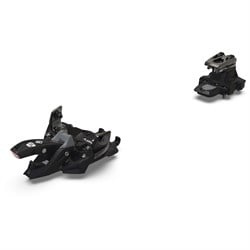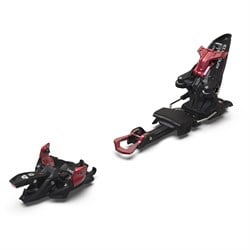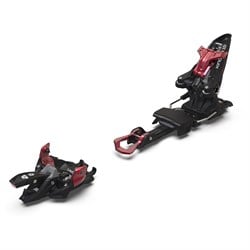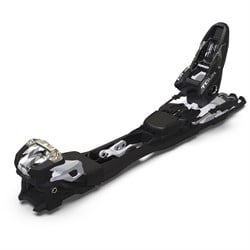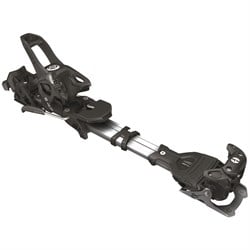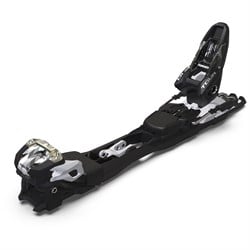How to Choose Touring, AT & Randonnee Ski Bindings
What Are AT or Touring Ski Bindings? How do They Work?
Alpine touring bindings (also known as "AT bindings" or "Randonnée bindings" if you're feeling continental) allow you to lift your heels naturally while skinning uphill, then lock your boots down and use regular alpine skiing technique when you want to go downhill. These are the bindings you use to access backcountry terrain. Used in combination with climbing skins and alpine touring boots that have a hinging upper cuff, AT bindings make traveling over snowy ground remarkably fast and efficient. If you’re planning on earning your turns and backcountry skiing, you’ll need to get some AT bindings. In this guide, we’ll break down how to choose touring bindings, and explain the uses of the different styles available.
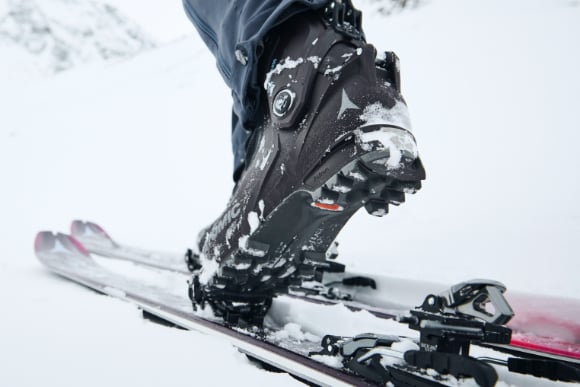
Types of AT and Touring Ski Bindings
Tech Touring Bindings
“Tech" ski touring bindings are sometimes referred to by the brand name Dynafit, although there are a number of brands that make them. They rely on a set of pins to hold the toe (and with a few exceptions, the heel) in place and require a special boot. Tech bindings are lightweight and allow for a natural walking motion on the skin track. There’s a deep selection of tech bindings, with options ranging from ultra light mountaineering styles to more elastic freeride models.
Pros
| Cons
|
Frame Touring Bindings
Frame touring bindings have toe and heel pieces connected by a frame or rails and often work with both alpine and alpine touring ski boots. Frame AT bindings are typically heavier, but don't require boots with tech fittings and give skiers an experience that is more similar to traditional alpine ski bindings. The beauty of frame bindings is that you can simply swap them out for your alpine bindings, get some climbing skins, and head out - with proper backcountry safety gear and knowledge, of course. They’ll be a bit less than ideal, but they’re safe, reliable, and easy to use, and any day skiing is better than no day of skiing, which makes frame bindings the right choice for a lot of people.
Pros
| Cons
|
Hybrid Touring Bindings
In recent years, hybrid touring bindings have seen a rise in popularity. These are bindings like the Marker Kingpin or the Fritschi Tecton, which have a tech toepiece for reduced weight and optimal touring mobility, but a traditional DIN certified heelpiece for responsiveness and safety on the way down. More recently, the Salomon Shift and the Marker Duke PT have become favorites in this category, offering full alpine DIN performance for the way down, and a frameless tech system for the way up. These hybrid bindings occupy a middle ground between burly frame bindings and ultralight tech setups, giving riders many of the benefits of each system. Due to the versatility of hybrid bindings, they have become increasingly popular for more agressive backcountry freeriding or use as a 50/50 resort and backcountry setup.Pros
| Cons
|
How to Choose Touring Ski Bindings
The basic axis to consider when buying touring bindings is uphill performance versus downhill performance. In the most general sense, the better the binding skis, the heavier it will be and the worse it will tour. Your task in selecting the right binding for you is figuring out where on the spectrum is most suited to your needs, and finding a binding that's light enough to enable the type of touring you want to do but powerful enough to accommodate your skiing style.
Uphill vs. Downhill
At one end of the spectrum, you have bindings like the Salomon Guardian 16 or the Marker Duke 18. These are burly freeride bindings with the ability to either free or lock down the heel. While these are the safest and most reliable option for sending mega-huge backcountry airs, the drawbacks of lugging their massive weight up the skin track and dealing with the clunky pivot mechanisms outweigh the benefits for many skiers.On the other end of the spectrum, you have bindings like the Salomon MTN and ATK Crest, with very low weights that’ll have you floating up the skin track, but with much less elasticity and fewer retention options (range of ISO/DIN settings) for the downhill. This kind of binding is best suited for fast and light setups, deep spring touring missions or multi-day traverses with lots of mileage and elevation, where light weight is a priority.
As with most things in life, somewhere in the middle is usually best for most people. Be honest with yourself when considering your ski style and the type of trips you'll be doing, and find the binding that has the right balance of uphill versus downhill performance for you.

How Much Time Do You Spend Inbounds?
Another important consideration in finding the right touring bindings is whether or not you plan to use them at the resort as well as the backcountry. If you already have a dedicated inbounds set up and you’re looking for a binding that will be used almost exclusively in the backcountry, you’ll probably want something on the more uphill oriented side of the spectrum. Since a good chunk of your day will be spent on the skin track, you'll want a tech or hybrid binding that's lightweight and excels on the uphill. If you’re looking for one setup that can see a good amount of use both touring and skiing lift-accessed terrain, you’re almost definitely going to want a hybrid binding. Hammering down mogul fields on tech bindings is not what you spent all that money on a lift ticket for, and lugging a frame binding up the skin track is going to make you reconsider your life choices after a long day in the backcountry. As long as you have tech fittings in your boots, a binding like the Salomon Shift is a direct upgrade to a frame binding for both the resort and the backcountry.
Other Considerations
Elasticity, DIN & Release Value
Unlike alpine bindings which release laterally at the toe, most tech bindings currently on the market have a fixed toe and are designed to release initially from the heel in both the lateral and vertical directions. When the boot has travelled far enough out of the normal ski position, it levers the toepiece open and the boot pops out. Hybrd bindings and some more freeride specific tech styles have provided a solution to this with laterally releasing toepieces, but if safety and consistent releases are at the top of your priority list, this is something to consider. Keep in mind that tech binding release values appear to use the same ISO/DIN scale as alpine bindings, but are not ISO/DIN certified like alpine bindings. The elasticity of tech bindings and the force required to cause a release won’t necessarily be the same as an alpine binding set at the same number.
Boot Compatibility
In general, most modern touring bindings of all categories are set up to work with most standard touring boot sole types, but as there are many variations, it's best to check the specific binding you're considering against your boot sole type. If you're looking at tech bindings, tech fittings are mandatory, so make sure your boot includes them (it is possible to have an ISO 9523, Walk-to-Ride, or GripWalk-soled boot without them). To further complicate matters, there are tech boots with very short soles or no toe lugs (non ISO 9523-conforming) that will only work with true tech bindings and not frame or hybrid styles. If in doubt about a specific boot and binding combination, ask your binding tech.
Read More About Ski Boot & Binding Compatibility Here >>>
Common Touring Binding Questions
Can I telemark on AT bindings?
No. AT bindings aren’t designed for the stresses of telemark skiing. Furthermore, AT bindings pivot in front of the toe, while telemark bindings and boots are designed to flex at the ball of the foot with a spring for rebound.Can I use alpine boots with touring bindings?
It depends. Most frame-type AT bindings have enough toe height adjustment to use with an alpine DIN boot, but tech bindings will not accept them. Also, skinning for long periods in heavy alpine boots that do not have a hinging hike mode can be quite uncomfortable.Can I use a tech binding for my everyday lift-served skis?
Maybe. Lighter, smoother skiers have been using traditional tech bindings for lift skiing for years, and the newer hybrid bindings are designed with 50/50 riding in mind. ISO 13992 certified tech bindings with greater elasticity and higher release values are also sometimes used by heavier expert skiers for lift served skiing, but there are limits. Remember that tech bindings may not perform like the alpine bindings you've been using even when adjusted to the same ISO/DIN settings.
Can I use a tech binding with a wide powder ski?
Yes. Wide skis place more stress on the boot/binding connection than narrow ones, but many people use this combination successfully. It’s often best to match your setup throughout for the best skiing experience. This means pairing a lightweight ski with lightweight bindings and boots, or a big ski with a more burly binding and boots. However, shaving weight with a lighter binding can allow you to have a wider ski without adding too much to the weight of the setup.Can I use a frame-type AT binding with big skis as my only setup?
Yes. Heavier frame bindings often use the same release mechanisms as their alpine counterparts and are extremely reliable.How about adapters that let me use the alpine bindings I already own?
There are a few systems that allow you to go into tour mode and still use your alpine bindings for skiing down. One example is the SI&I CAST System. This system allows you to use regular alpine bindings for the descent, but slide in a Dynafit Radical toepiece instead of your regular alpine toe for skinning. The CAST system requires a modification to your alpine boots so that they can be used with the Dynafit toes. Another option is the MFD Alltime Plate. This plate is mounted to your skis, alpine bindings are mounted to it, and the MFD plate hinges up and down - the MFD system is heavy and no longer in production. The BCA Alpine Trekker is a system that fits into your alpine bindings and holds your boots securely while allowing the heels to lift; you remove them and put them in your pack to ski down. These options could be a solution if you prefer your alpine bindings with extremely high release values, don’t need to skin far, or aren’t afraid to carry the extra weight uphill.
We recommend that backcountry travelers take an AIARE Level One class or equivalent and practice the skills they learn there regularly with their partners. Here are some great resources for avalanche safety education:
— American Institute for Avalanche Research and Education
— American Avalanche Association
— Northwest Weather and Avalanche Center
— Avalanche Canada
You should carry an avalanche beacon, shovel and probe when travelling in avalanche terrain and know how to use them. Backcountry travel requires an acceptance of the risks involved (avalanches are not the only danger) and implies a willingness to take responsibility for educating oneself about these dangers and ways to mitigate them.
Learn More With Our Other Backcountry Guides:
- Backcountry Basics - How to Get Started
- Backcountry Gear - Checklist
- Backcountry Backpacks - How to Choose
- Avalanche Beacons / Transceivers - How to Choose
- Avalanche Shovels - How to Choose
- Avalanche Probes - How to Choose
- Avalanche Airbags - How to Choose
- Alpine Touring Skis - How to Choose
- Alpine Touring Ski Boots - How to Choose
- Alpine Touring Ski Bindings - How to Choose
- Dynafit (Tech) Bindings - Getting Started
- Backcountry Basics - How to Skin
- Climbing Skins - How to Choose
- Climbing Skins - Size Guide
- Climbing Skins - Weight Chart
- Climbing Skins - How to Cut/Trim
- Outerwear & Layers - How to Dress for the Backcountry
- Splitboarding - How to Get Started
Discover Our Favorite Gear:
This is evo. We are a ski, snowboard, wake, skate, bike, surf, camp, and clothing online retailer with physical stores in Seattle, Portland, Denver, Salt Lake City, Whistler, and Snoqualmie Pass. Our goal is to provide you with great information to make both your purchase and upkeep easy.
evo also likes to travel to remote places across the globe in search of world-class powder turns, epic waves, or legendary mountain biking locations through evoTrip Adventure Travel Trips. Or, if you prefer to travel on your own, check out our ski & snowboard resort travel guides and mountain bike trail guides.
Still have questions? Please call our customer care team at 1.866.386.1590 during Customer Care Hours. They can help you find the right setup to fit your needs.

